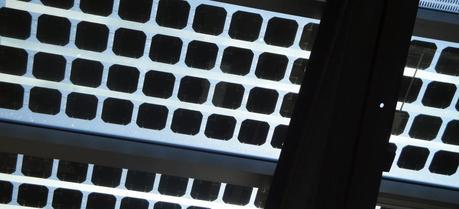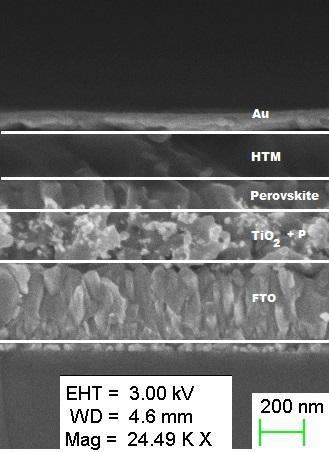 Solar panels in Aspen, Colorado. (Credit: SolarDave.com)
Solar panels in Aspen, Colorado. (Credit: SolarDave.com)
Lead halide perovskites have recently been used as light absorbers in hybrid organic–inorganic solid-state solar cells, with efficiencies as high as 15% and open-circuit voltages of 1 V. However, a detailed explanation of the mechanisms of operation within this photovoltaic system is still lacking. Scientists from Ecole polytechnique fédérale in Lausanne (EPFL) and of HZB-Institute for Solar Fuels have now uncovered the mechanism by which these novel light-absorbing semiconductors transfer electrons along their surface.

Scanning electron microscopy of a perovskite solar cell: on a glass substrate (glass and FTO) highly porous titanium dioxide is deposited, which is impregnated with perovskite. This film is covered by an organic hole transporting material (HTM) and gold contact. (Credit: EPFL).
They examined perovskite based solar cells with different architectures with time resolved spectroscopy techniques. Their results, which are now published online in Nature photonics (see footnote), open the way to the design of photovoltaic converters with improved efficiency.
The groups of Michael Gratzel and Jaques E. Moser at EPFL, working with the team of Roel van de Krol at HZB-Institute for Solar Fuels, have used time-resolved spectroscopy techniques to determine how charges move across perovskite surfaces. The researchers worked on various cell architectures, using either semiconducting titanium dioxide or insulating aluminum trioxide films. Both porous films were impregnated with lead iodide perovskite (CH3NH3PbI3) and an organic “hole-transporting material”, which helps extracting positive charges following light absorption. The time-resolved techniques included ultrafast laser spectroscopy and microwave photoconductivity.
The results showed two main dynamics. First, that charge separation, the flow of electrical charges after sunlight reaches the perovskite light-absorber, takes place through electron transfer at both junctions with titanium dioxide and the hole-transporting material on a sub-picosecond timescale. “Secondly, we could measure by microwave photoconductivity that charge recombination was significantly slower for titanium oxide films rather than aluminum ones”, Dennis Friedrich from the van de Krol Team points out. Charge recombination is a detrimental process wasting the converted energy into heat and thus reducing the overall efficiency of the solar cell”
The authors state that lead halide perovskites constitute unique semiconductor materials in solar cells, allowing ultrafast transfer of electrons and positive charges at two junctions simultaneously and transporting both types of charge carriers quite efficiently. In addition, their findings show a clear advantage of the architecture based on titanium dioxide films and hole-transporting materials.
Arianna Marchioro, Joël Teuscher, Dennis Friedrich, Marinus Kunst, Roel van de Krol, Thomas Moehl, Michael Grätzel, Jacques-E. Moser (2014). Unravelling the mechanism of photoinduced charge transfer processes in lead iodide perovskite solar cells Nature Photonics DOI: 10.1038/nphoton.2013.374
